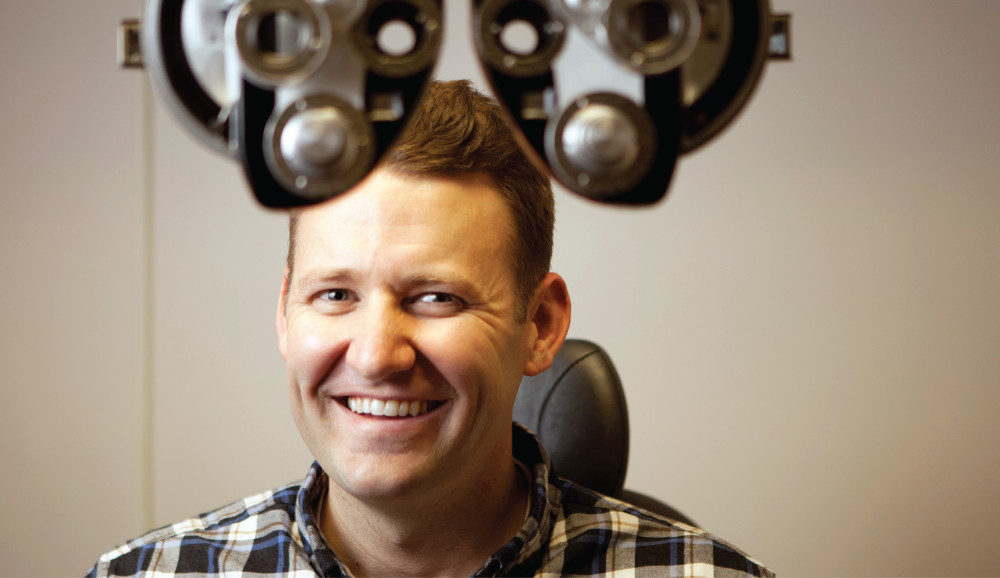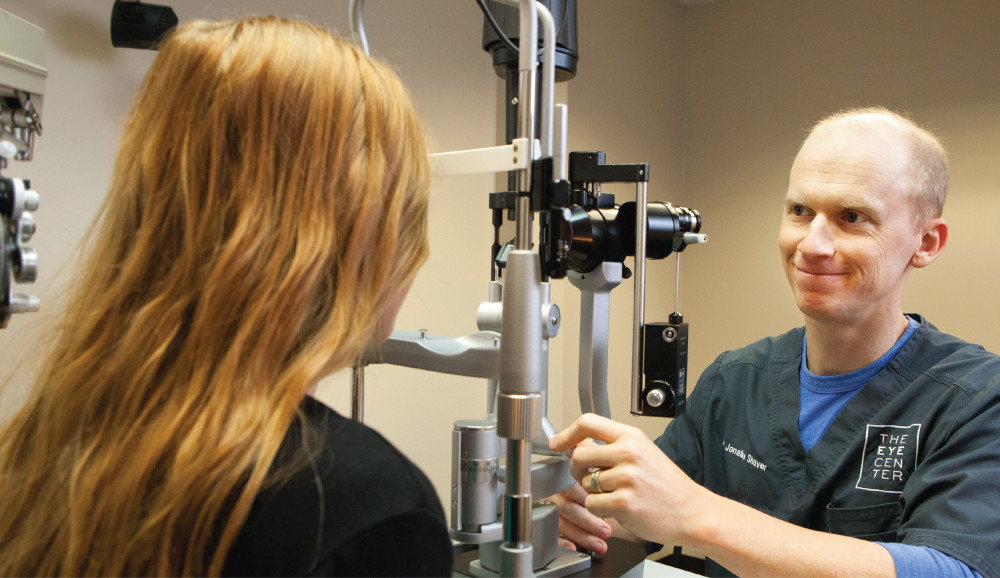Regular eye exams are essential for your vision health, of course, but they can also be an important part of your overall health and wellness.
Your eye exam may include some or all of the following exams:
Visual Acuity Test
This is probably the test you think of when you first think about eye exams. You’ll cover one eye at a time and be asked to read from an eye chart. There are different kinds of eye charts, but they will usually begin at the top with the largest letters or numbers, and the letters and numbers will become smaller as you read down the chart.
Usually you’ll be asked to read the smallest line you can. 20/20 vision means that you can read the line at a distance of 20 feet that a person with perfect vision would be able to read at 20 feet. If your vision is 20/40, then you can read at 20 feet the line that a person with perfect vision is able to read while standing 40 feet from the chart.
Visual Field Test
A visual acuity test checks how sharp your sight is when you’re focusing on something ahead of you. A visual field test checks your peripheral vision – what you can see outside your main focus. If you’ve ever talked about seeing something from the corner of your eye, you were talking about peripheral vision.
A confrontation visual field test is the most common type of visual field test in eye exams. You will be asked to cover one eye and focus on (usually) the doctor’s eye, while your eye doctor or technician presents objects in different areas. You’ll be asked to say when you see the object, to count the doctor’s fingers, or in other ways to demonstrate what you can see.

Refraction Assessment
The refraction assessment helps your eye doctor determine your prescription for glasses or contact lenses, if needed.
You will be asked to look through a phoroptor, a device that lets you try out different lenses. You’ll be asked to choose which lens gives you a clearer view. Your answers will help your eye doctor decide what prescription will work best for you.
Retinoscopy
While a refraction assessment requires you to judge whether one lens gives you a clearer view than another, a retinoscopy test lets your eye doctor check refraction (the way light reflects from your eyes) directly.
You will be asked to look through a lens and focus on an object. Your doctor will shine a light in your eye and will use the way the light reflects to determine the correct prescription for your glasses or contacts. Your eye doctor may use both refraction assessment and retinoscopy to get a precise determination of your prescription.
When working with a baby or another individual who cannot help with the collaboration involved in refraction assessment, your eye doctor may use retinoscopy alone.
Autorefractor Testing
An autorefractor is a machine that automatically tests the refraction of your eye. It may be used in combination with the tests discussed above, or it may be used instead of other refraction tests for children and others who might have trouble cooperating with refraction testing.
For an autorefractor test, you’ll put your chin in place in the machine and focus on a small object while the machine gets data about your eyes. Your eye doctor will interpret the data.

Slit-Lamp Examination
A slit-lamp examination uses a microscope and a strong light to examine the cornea, iris and lens, and the structures at the front of the eye very closely. It can also be used to study the back of the eye, but this would require dilation. This test looks for conditions such as cataracts, dry eye syndrome, damage to the cornea, and macular degeneration (a condition of the eye related to aging).
Your eye doctor might use a yellow dye to help certain parts of the eye stand out for examination.
Glaucoma Testing
Glaucoma is a disorder that damages the optic nerve, which sends visual images to your brain. It can lead to blindness if left untreated. Glaucoma tests measure the pressure inside your eye, which can be a risk factor for glaucoma. At The Eye Center, we use applanation tonometry, which measures the pressure inside your eyes by detecting how much force is needed to temporarily flatten an area of your cornea. This means there is no puff of air to worry about.
During the test, your eyes will be anesthetized using eye drops, and your eye doctor will place a probe against your cornea. At the very end of the probe, there are two green semi-circles on a filter. A blue light will be cast on your eye so the doctor can look through the probe and examine these green semi-circles. The two semi-circles should touch, and your eye doctor will turn a dial to apply force to the cornea in order to make the semi-circles meet. The amount of force used will help determine the pressure inside your eye. If there are concerns, you may need further tests.
Optical Coherence Tomography (OCT)
You might be familiar with ultrasound, in which sound waves are bounced off the internal organs to get a clear picture of the inside of the body. Optical Coherence Tomography is similar but light waves are used instead of sound waves.
This non-invasive diagnostic test allows your eye doctor to get an in-depth look at the entire eye. Some of the things that your eye doctor might be able to see are macular holes, macular degeneration, macular edema, central serous chorioretinopathy, epiretinal membranes, schisms cavities, and retinal inflammatory diseases. Optical Coherence Tomography can also help with the early detection of glaucoma, diabetic retinopathy, and optic nerve damage.
Like other imaging methods, Optical Coherence Tomography is safe and painless.
Dilated Fundus Examination
One of the reasons eye exams can involve so many different kinds of test is that the eye is a very complex organ, and most of it is not visible. This makes your eye exam very different from, say, an examination of your knee.
The funds is the part of the eye where the optic nerve and retina can be seen. You may hear it referred to as “the back of the eye.” The only way to see the bulk of the eye is to look through the pupil. Therefore, the pupil is dilated to make a larger opening and will give the doctor a better view. Once the pupil is dilated, your eye doctor may use an indirect ophthalmoscope to get a good look at the inside of the eye.
